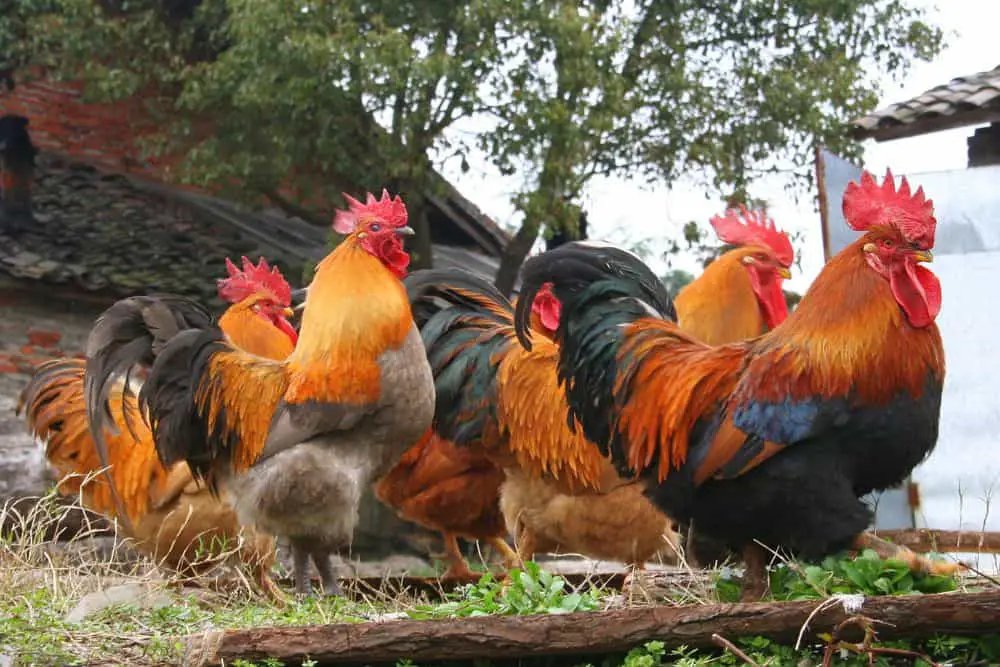Many people think that all male chickens are roosters, but this is not actually the case. When they are less than a year old they are called cockerels or cocks. So, what happens to these cockerels when they grow up? Do they all become roosters? Read on to find out.
What is a Rooster?
A rooster is a mature male chicken who is responsible for fertilizing the eggs laid by the hens in the flock. He will also protect the flock from predators and help to keep them warm at night by sleeping in the middle of the group. Not all male chickens grow up to be roosters, however. When they are less than a year old, they are called cockerels or cocks. So, what happens to these cockerels when they grow up?
Do All Male Chickens Become Roosters?
No, not all male chickens become roosters. In many commercial operations, the cockerels are culled (i.e., killed) when they are young because they do not lay eggs, and their meat is not as tender as that of hens. In some cases, however, cockerels may be allowed to grow up and become roosters. This generally only happens in smaller operations where there is a need for a breeding rooster.
How Can You Tell If a Chick Is a Rooster?
With so many different chicken breeds available, it can be hard to keep track of which ones are roosters and which ones are hens. While you can usually tell by the size and appearance of an adult chicken, it can be nearly impossible to tell the difference between a male and a female chick. So, how can you tell if a chick is a rooster?
You can tell if a chick is a rooster in a few different ways. One of the most reliable methods is called vent sexing. This involves examining the chick’s vent, which is an opening located at the base of the tail that serves as the exit for waste products. In male chicks, the vent will protrude slightly and have a smooth, slightly concave shape. In female chicks, the vent will be smaller and less protrusive, with a more rounded appearance.
Another way to tell the difference between male and female chicks is by looking at their feathers. Male chicks typically have longer, pointier feathers on their wings, while female chicks have shorter, rounder feathers. Additionally, male chicks typically have brighter plumage than female chicks. However, it should be noted that this method is not always reliable, as there are some chicken breeds in which males and females have similar feathering.
Listening to their chirp is the third and final way to tell if a chick is a rooster. Male chicks tend to chirp at a higher pitch than female chicks. Male chicks also chirp more frequently than female chicks. However, this method is also not foolproof, as there are some chicken breeds in which both male and female chicks chirp at similar pitches.
What’s the Difference Between a Cockerel and a Rooster?
In American English, we often use the terms “cockerel” and “rooster” interchangeably. However, there is actually a difference between these two words. A cockerel is a young male chicken, while a rooster is an adult male chicken. Let’s take a closer look at these two terms to see how they differ.
The Difference in Age
Cockerels are young male chickens that have not yet reached sexual maturity. Roosters, on the other hand, are adult male chickens that are fully sexually mature. In most cases, cockerels will reach sexual maturity by the time they are 6 months old, at which point they will start to crow and develop the physical characteristics of an adult rooster.
The Difference in Size
Cockerels tend to be smaller than roosters since they are still growing and haven’t reached their full size yet. Roosters, on the other hand, have usually reached their full size by the time they reach sexual maturity. This means that roosters are typically larger than cockerels, though there can be some overlap between the two groups in terms of size.
The Difference in Behavior
Cockerels and roosters also tend to have different behaviors. Cockerels are usually more timid and less aggressive than roosters since they haven’t established their place in the pecking order yet.
Roosters, on the other hand, are usually more confident and assertive since they know their place in the flock. This difference in behavior can also be seen in how cockerels and roosters interact with humans.
Cockerels are often more friendly and less shy around humans than roosters since they haven’t learned to be afraid of them yet. Once they reach adulthood, however, most roosters will start to avoid humans unless they’ve been handled frequently or have been socialized with humans from a young age.
How Are Roosters Different to Hens?
If you’ve ever wondered how roosters differ from hens, then you’re not alone. It’s a common question that we get here at the farm. Let’s take a closer look at the differences between these two barnyard staples.
Appearance
One of the most obvious ways to tell a rooster apart from a hen is by their appearance. Roosters are generally larger than hens and have brightly colored plumage. They also have a distinctive “crowing” sound that they make, which is often used in cartoons and movies to represent the early morning hours.
Hens, on the other hand, are generally smaller than roosters and have more muted colors in their feathers. They also don’t make the same “crowing” sound as roosters; instead, they make a softer “clucking” noise.
Temperament
Another way to tell these two birds apart is by their temperament. Roosters are known for being quite aggressive, especially when it comes to protecting their flock of hens. They will often attack other animals (and even humans!) that they perceive as a threat.
Hens are much more docile than their male counterparts and aren’t typically known for being aggressive. However, they can be protective of their young chicks if they feel like they are in danger.
Behavior
Roosters and hens also differ in terms of their behavior. Roosters will often strut around and preen themselves when they are trying to attract a mate. They will also “cock-a-doodle-doo” to let the hens know that they are available for breeding.
Hens generally don’t engage in this type of behavior; instead, they will usually just wait for the rooster to come to them when they are ready to breed.
How Long Do Roosters Live?
Ever wonder how long your favorite barnyard animal will stick around? When it comes to roosters, the average lifespan is 5-8 years. However, many factors contribute to how long a rooster will live.
Diet and Nutrition
One major factor in how long any animal lives is its diet and nutrition. A rooster that is well-fed and has access to plenty of fresh water will likely live longer than a rooster that does not have a good diet.
In addition, a rooster that free ranges and has access to plenty of greens will also have a better chance at a longer lifespan. For example, vitamin C is an important nutrient for immune health, and kale is an excellent source of vitamin C. So, if your rooster free ranges and likes to munch on some kale from time to time, he’s getting a big boost to his immune system!
Living Conditions
Another important factor in how long a rooster lives is the living conditions. A rooster that lives in a clean, spacious coop with plenty of ventilation will likely live longer than a rooster that lives in cramped quarters with poor ventilation.
In addition, a rooster living in a calm environment with little stress will likely have a longer lifespan than a rooster living in a high-stress environment. For example, if your coop houses multiple roosters constantly fighting for dominance, this high-stress level can take years off their life expectancy.
Environment
The environment also plays a role in how long a rooster lives. Roosters that live in areas with mild weather conditions will likely have a longer lifespan than those that live in areas with extreme weather conditions.
For example, if you live in an area with very cold winters, your rooster will need extra shelter and protection from the elements in order to survive. On the other hand, if you live in an area with very hot summers, your rooster will need extra shade and water to stay cool and avoid heat exhaustion or heat stroke.
Do We Eat Roosters?
We all know that we eat chicken, but do we eat roosters? The answer might surprise you. While most chickens raised for food are females, it is possible to find and eat male chickens.
The primary difference between a rooster and a hen is that a rooster is male and a hen is female. Hens are usually raised for their meat and eggs, while roosters are typically used for breeding or, in some cases, discarded since there isn’t a demand for them. However, there is no reason why a rooster can’t be raised for meat. In fact, in some cultures, it is traditional to eat roast cock!
One of the benefits of eating roosters is that they tend to be larger and have more muscle than chickens. Another reason to consider eating roosters is that they are usually cheaper than hens. This is because there is less demand for them.
In Summary – Are All Male Chickens Roosters?
When it comes to telling male and female chickens apart, there are three main methods that you can use: vent sexing, feather examination, and chirp analysis. Of these three methods, vent sexing is generally considered to be the most reliable.
However, all three methods have their own strengths and weaknesses, so it’s important to use all three methods together in order to get the most accurate result possible.

